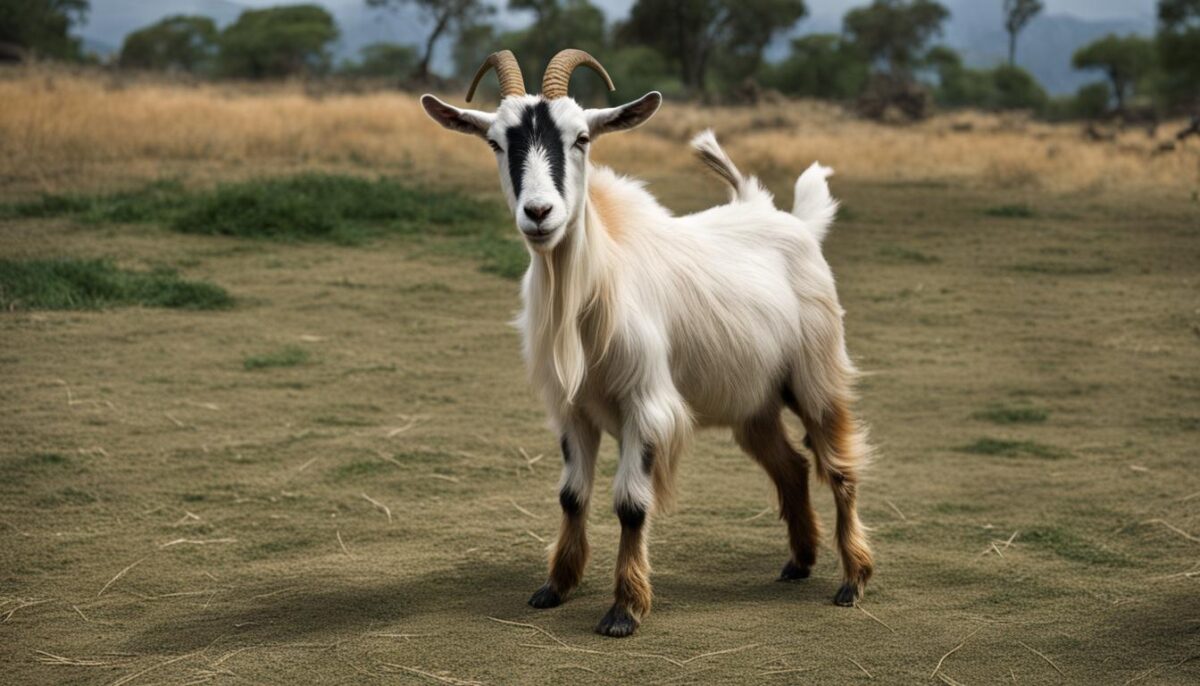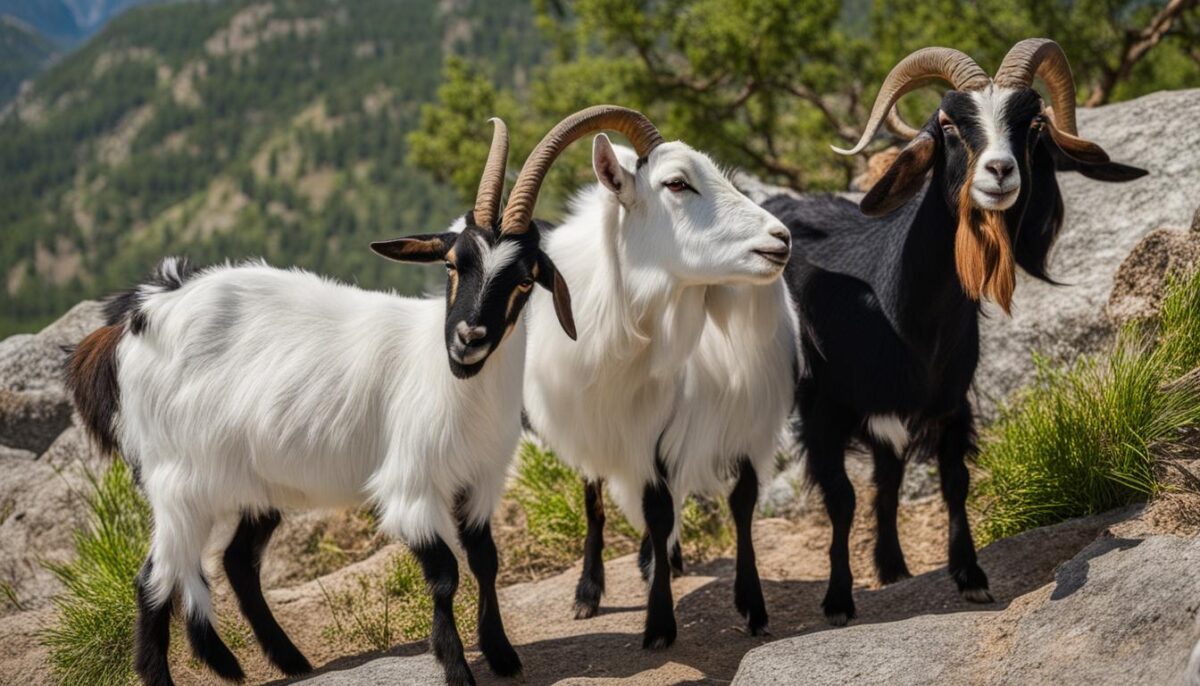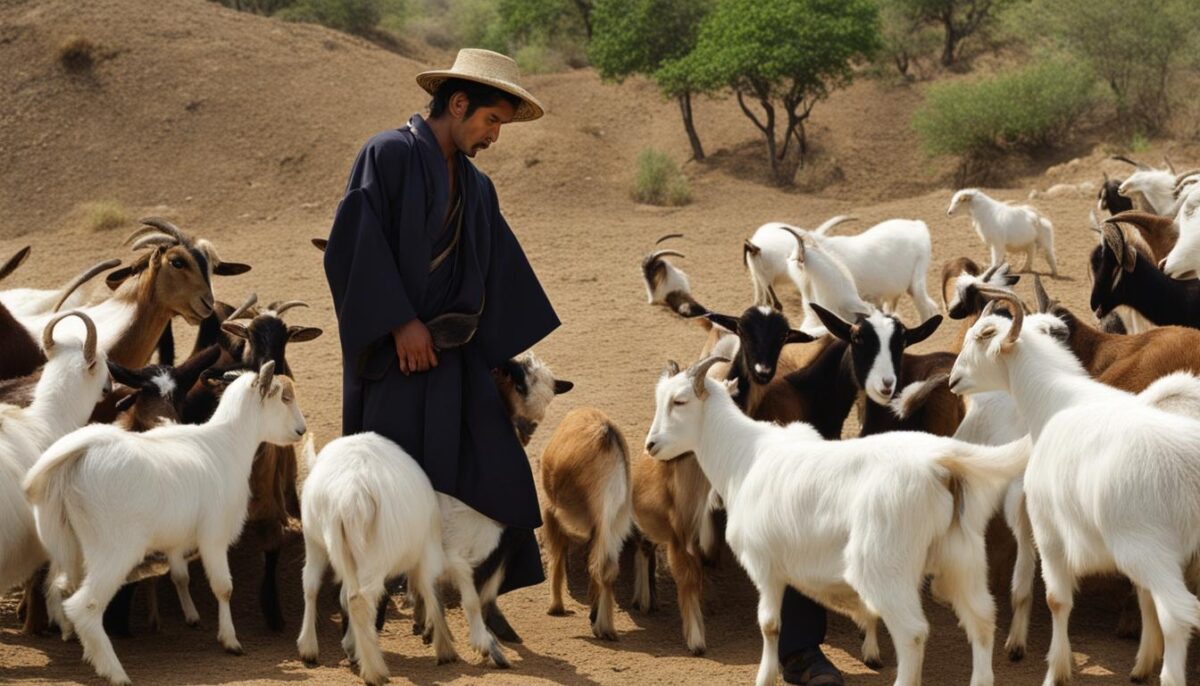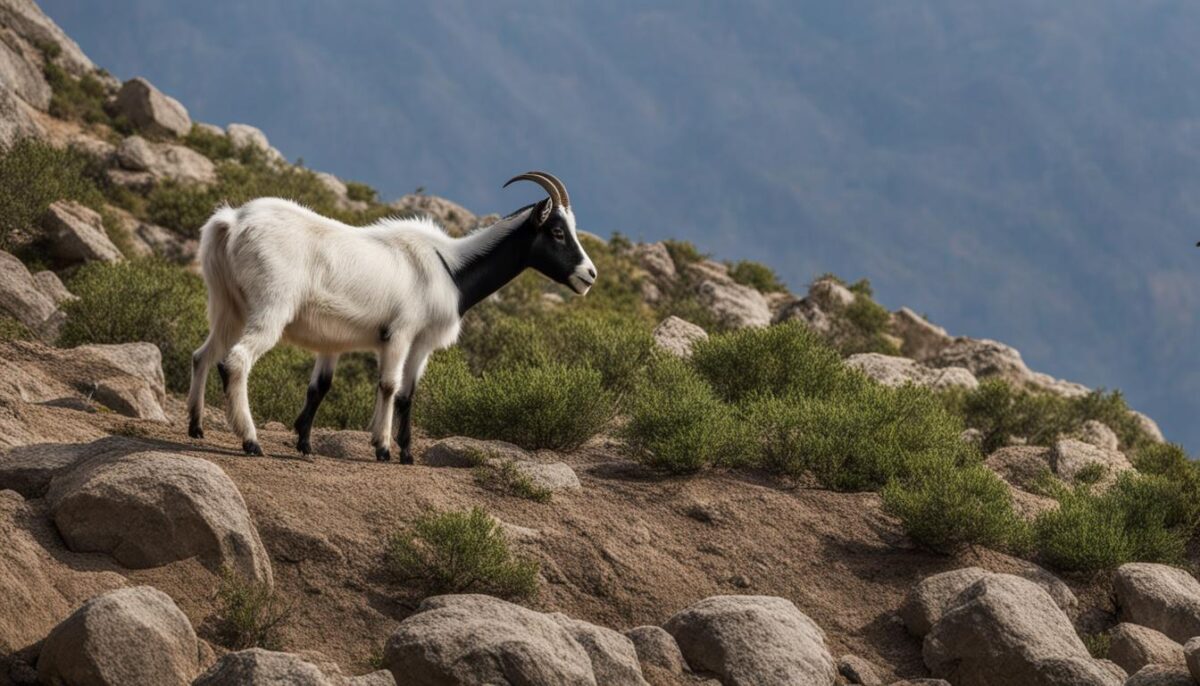Did you know that male billy goats have a peculiar grooming habit? During the breeding season, they engage in a behavior called self-enurination or scent-urination. This means that they deliberately pee on their own faces, beards, and front legs. While this may seem strange to us, it serves a purpose in the goat kingdom. Let’s explore more about this intriguing behavior and its implications for goat behavior and grooming habits.
Key Takeaways:
- Billy goats engage in self-enurination during the breeding season, where they pee on their faces, beards, and front legs.
- This behavior is believed to attract estrous females and potentially synchronize estrus.
- The exact function of self-enurination in goats is still unknown, but it likely serves as a way to emit olfactory cues for mating.
- Hormones play a role in goat urination behavior, with testosterone regulating urine marking behaviors.
- The scent and chemical cues in male goat urine can influence female mate choice and even impact the flavor of goat milk.
The Role of Hormones in Goat Urination Behavior
Goat urine plays a crucial role in their unique self-enurination behavior. This behavior is regulated by hormones, particularly testosterone. Elevated testosterone levels in male goats activate sebaceous scent glands, contributing to the characteristic odor of male goats. Chemical cues in the urine have been shown to function as sexual attractants in various animal species. In goats, urine marking behaviors occur more frequently during the breeding season, when testosterone levels are high.
Interestingly, not only male goats exhibit this behavior. Castrated males and hormone-treated females also produce pheromones in their urine that can induce reproductive responses in females. However, the specific pheromones and their effects in goat urine have yet to be fully studied. Understanding the role of hormones in goat urination behavior can provide valuable insights into goat biology and reproductive strategies.
“Chemical cues in urine have been shown to function as sexual attractants in various animal species.”
Hypotheses on the Function of Self-Enurination in Goats
The exact function of self-enurination in goats is still uncertain. One hypothesis suggests that it is a way for males to apply urine to their bodies and emit olfactory cues to attract estrous females for mating. Additionally, the scent of urine may play a role in hastening the onset of estrus and synchronizing the breeding season. Similar hypotheses have been proposed in other species, but further research is needed to confirm these theories.
Goat characteristics and unique animal behaviors make self-enurination an intriguing phenomenon. By urinating on themselves, male goats may be engaging in a form of grooming that helps them maintain their hygiene and attractiveness to potential mates. This behavior could also serve as a means of communication, with the scent of urine conveying an essential message to receptive females. However, these hypotheses are still speculative and require more scientific investigation.
Understanding the purpose behind self-enurination in goats could provide valuable insights into the evolutionary significance of this behavior. By unraveling the function and mechanisms involved, researchers can gain a deeper understanding of goat biology and the complex social dynamics within goat populations. Further studies exploring the chemical composition of goat urine and its effects on female reproductive responses are essential to shed light on this intriguing aspect of goat behavior.
Table: Hypotheses on the Function of Self-Enurination in Goats
| Hypothesis | Description |
|---|---|
| Scent Attraction | Self-enurination is a way for males to emit olfactory cues that attract estrous females for mating. |
| Estrus Synchronization | The scent of urine may help hasten the onset of estrus and synchronize the breeding season in goats. |
| Grooming Behavior | Self-enurination could be a form of grooming that helps male goats maintain hygiene and attractiveness. |
| Communication Signal | The scent of urine may serve as a means of communication between male goats and receptive females. |

Female Preferences and Male Behavior during Rut
Female goats have unique preferences when it comes to choosing their mates during the rut. While it may seem surprising, females have been observed to prefer the urine of males that engage in self-enurination, a behavior where males urinate on their own faces and beards. This behavior is believed to be an important signal to females, indicating the availability and quality of the males for breeding. Female goats may be attracted to the scent and chemical cues present in the urine, which helps them make informed decisions when choosing a mate.
During the rut, male goats exhibit interesting behaviors that are part of their natural reproductive process. They rub their horns and scent glands on various objects to spread their musky scent, creating a distinctive odor. While these behaviors may seem unusual to us, they play an essential role in attracting females and signaling their readiness to mate. Male goats become more active and vocal during the rut, engaging in displays of dominance and aggression to establish their position and compete for access to females. Understanding these behaviors is crucial for breeders to ensure successful mating and reproduction in their goat herds.
“Female goats have unique preferences when it comes to choosing their mates during the rut. They have been observed to prefer the urine of males that engage in self-enurination.”
The Impact of Female Preferences on Reproductive Success
Female mate choice based on male urine scent cues can have significant implications for reproductive success in goats. By selecting males that exhibit self-enurination, females may increase the likelihood of successful fertilization and the production of healthy offspring. It is believed that the scent and chemical cues present in the urine play a crucial role in stimulating reproductive responses in females, potentially leading to synchronized estrus and improved breeding outcomes. This unique aspect of goat reproduction adds to the quirky and fascinating nature of these animals.
| Female Preferences during Rut | Male Behavior during Rut |
|---|---|
| Preference for males with self-enurination behavior | Engaging in self-enurination to attract females |
| Sensitivity to scent and chemical cues in male urine | Rubbing horns and scent glands on objects to spread musky scent |
| Choosing mates based on reproductive potential | Displaying dominance and aggression to establish mating opportunities |
The Impact of Goat Reproduction on Milk Flavor
During the breeding season, male goats, also known as bucks, emit strong odors as part of their reproductive behavior. If milking does are housed near bucks in rut, the milk can absorb these musky odors, resulting in a change in flavor. This can negatively affect the taste and quality of the goat milk produced. To prevent any off-flavors in the milk, it is recommended to keep the female goats separate from the males during the breeding season.
Table: Goat Milk Flavor Impact
| Issue | Description |
|---|---|
| Off-flavors | If does are exposed to buck odor, the milk may have a musky taste. |
| Quality deterioration | The presence of buck odor in milk can affect its overall quality and market value. |
| Consumer dissatisfaction | Off-flavors in goat milk may lead to reduced consumer satisfaction and lower demand. |
By housing the female goats separately, breeders can ensure that the milk remains free of any unwanted flavors. This is especially important for goat dairies that focus on producing high-quality milk and dairy products. Keeping a distance from bucks in rut and maintaining good hygiene practices can also help minimize any potential contamination of milk with buck odor.
It’s important to note that the impact of goat reproduction on milk flavor is temporary and limited to the breeding season. Once the breeding season is over and the bucks are no longer in rut, the milk should return to its normal flavor profile. Proper management of goat reproduction plays a crucial role in maintaining the desired quality and taste of goat milk.
The Challenges of Goat Reproduction Management
Managing the reproduction of goats can be a complex and demanding task. The breeding season, gestation period, and the behaviors exhibited by bucks and does during this time require careful planning and monitoring to ensure successful outcomes. Here we explore some of the challenges involved in goat reproduction management.
Behavioral Challenges during the Breeding Season
The breeding season in goats can be a challenging time due to the behaviors exhibited by bucks. As they enter rut, bucks may become more aggressive and territorial, posing a potential risk to handlers. It is important to exercise caution and take necessary safety precautions when working with bucks during this period.
Furthermore, does can also display restlessness and a decreased appetite during the breeding season. This can make it more difficult to monitor their heat cycles and accurately determine the optimal time for breeding. Close observation and regular monitoring of does’ behaviors and physical signs can help ensure successful impregnation.
Monitoring Heat Cycles and Gestation
Properly managing the breeding season requires a thorough understanding of the heat cycles in does. Heat detection methods such as visual observation, use of teaser bucks, or hormone testing can aid in identifying the optimal time for breeding. Implementing an effective heat detection strategy is crucial to maximize breeding success rates.
Once a doe is successfully bred, monitoring the gestation period is essential. Gestation in goats typically lasts around 145 to 155 days, but individual variations may occur. Keeping track of breeding dates and observing physical signs of impending parturition, such as ligament softening and udder development, can help predict the approximate due date and ensure timely preparations for the birthing process.
| Challenge | Management Approach |
|---|---|
| Aggressive behavior of bucks during rut | Exercise caution and implement safety measures when handling bucks |
| Restlessness and decreased appetite in does during breeding season | Monitor behaviors and physical signs to accurately determine heat cycles |
| Monitoring heat cycles | Implement effective heat detection methods for optimal breeding timing |
| Monitoring gestation period | Keep track of breeding dates and observe physical signs of impending parturition |
Successfully managing the challenges of goat reproduction involves careful planning, thorough observation, and timely intervention when necessary. By understanding the behaviors exhibited during the breeding season, monitoring heat cycles, and effectively managing the gestation period, breeders can increase the likelihood of successful pregnancy and subsequent milk production.

The Birth Process in Goat Reproduction
During the gestation period of around 145 to 155 days, goats go through a unique birthing process. As the due date approaches, there are several signs that indicate impending labor. These include the softening of ligaments, the udder “bagging up” or enlarging with milk, and the presence of mucus discharge from the vulva.
When labor begins, the normal birth presentation involves the appearance of the amniotic sac followed by the front hooves and nose. The kid is then delivered headfirst. However, it is essential to be aware that complications can occur, and assistance may be required if the presentation is abnormal or the mother is experiencing difficulties.
The birth process in goats is both fascinating and crucial to ensure the success of goat reproduction. Being attentive to these signs and prepared to provide assistance when necessary is vital for the health and well-being of the mother and her offspring.
Table: Common Signs of Impending Goat Labor
| Signs of Impending Labor | Description |
|---|---|
| Softening of ligaments | As labor approaches, the ligaments around the tailhead and hips become looser, allowing for easier delivery. |
| Udder “bagging up” | The udder enlarges and fills with milk, preparing for nursing after delivery. |
| Mucus discharge from the vulva | A clear or slightly cloudy discharge from the vulva indicates that labor is near. |
“The birth process in goats is both fascinating and crucial to ensure the success of goat reproduction.”
Dealing with the Smell of Bucks in Rut
Bucks in rut produce strong odors as part of their reproductive behavior. The musky scent can be overwhelming and can permeate clothes, making it difficult to get rid of the smell. To avoid being rubbed on by bucks and to prevent the odor from lingering, it is best to keep a distance from them during this period. This might require changes in the housing arrangements or keeping the bucks in separate enclosures. It is also important to take precautions to maintain personal hygiene.
“The smell of bucks in rut can be quite pungent and distinctive. It is a natural part of their reproductive behavior, but it can be off-putting to humans. To minimize the impact of the odor, it is recommended to wash any clothing or equipment that comes into contact with the bucks frequently. Using detergents with strong fragrances or adding vinegar to the wash can help neutralize the smell. Additionally, using air fresheners or odor-absorbing products in the vicinity of the bucks can help mask the odor.”
Proper ventilation in the buck’s housing area is also crucial to prevent the accumulation of strong odors. Providing adequate airflow can help dissipate the smell and maintain a more pleasant environment. Regular cleaning of the housing area, including removing soiled bedding and urine patches, can also help reduce the intensity of the odor. It is important to note that the odor produced during rut is temporary and will subside once the breeding season is over.
Managing Buck Odor: Tips and Tricks
Here are some additional tips for managing buck odor during rut:
- Use natural odor neutralizers, such as baking soda or activated charcoal, to absorb the smell in the buck’s housing area.
- Consider using hormonal treatments to suppress buck odor. Consult with a veterinarian for appropriate options and dosage.
- Place physical barriers, such as solid partitions or fences, between the bucks and other animals to minimize direct contact and transfer of odor.
- Implement a regular grooming routine for the bucks, including trimming the hair around their scent glands, to reduce the spread of odor-causing substances.
By implementing these strategies, breeders can effectively manage the smell of bucks in rut and create a more pleasant environment for both humans and animals.
| Tip | Description |
|---|---|
| Use natural odor neutralizers | Products like baking soda or activated charcoal can help absorb and neutralize the buck odor. Sprinkle them in the housing area for better results. |
| Consider hormonal treatments | Consult with a veterinarian to discuss hormonal options that can help suppress the intensity of the buck odor during rut. |
| Use physical barriers | Separate bucks from other animals using solid partitions or fences to prevent direct contact and transfer of odor. |
| Implement a grooming routine | Regularly trim the hair around the bucks’ scent glands to reduce the spread of odor-causing substances. |

Goat Reproduction Seasonality
Understanding the seasonality of goat reproduction is essential for successful breeding and herd management. Most goat breeds are seasonal breeders, meaning they have specific periods of the year when they are sexually active and fertile. The breeding season for goats typically occurs from late July to December, coinciding with the decreasing daylight hours. During this time, both male and female goats exhibit behaviors and physiological changes associated with mating.
Male goats, or bucks, become more active and aggressive during the breeding season. They may display dominance behaviors, such as head-butting and vocalizations, to establish their hierarchy and attract females. Bucks also produce strong musky odors as part of their reproductive behavior, which can be off-putting to humans but serves as a natural attractant for does.
Female goats, or does, go through heat cycles during the breeding season. They become more receptive to mating and may display physical cues such as swollen vulva and increased urination. It is crucial for breeders to monitor the heat cycles of their does and introduce them to the bucks at the optimal time for successful mating.
| Season | Behavioral Changes | Physiological Changes |
|---|---|---|
| Late July – August | Male goats become more active and aggressive | Female goats start showing signs of heat cycles |
| September – October | Male goats exhibit dominance behaviors | Female goats are in estrus and receptive to mating |
| November – December | Male goats produce strong musky odors | Female goats may display physical cues of mating readiness |
“Understanding the seasonality of goat reproduction is crucial for successful breeding and herd management.”
By being aware of the seasonal breeding patterns, goat breeders can optimize their breeding programs and increase the chances of successful pregnancies. It is also important to provide proper nutrition and care during the breeding season to support the overall reproductive health of the goats.
Goat Reproduction Drama and Advice
During the breeding season, goat reproduction is accompanied by a range of dramatic behaviors exhibited by bucks and does. Understanding these behaviors and being prepared for the challenges that come with goat reproduction is essential for successful goat breeding and herd management.
Bucks in rut can become aggressive, especially when they are competing for mates. It is important to exercise caution around them to avoid any potential injuries. Keeping males and females housed separately during the breeding season is recommended to prevent unwanted breeding and maintain milk quality. This segregation also helps to minimize the strong musk odor associated with bucks in rut, which can permeate clothes and be difficult to remove.
Welcoming new kids to the herd is an exciting time for goat breeders. It is essential to monitor the birth process closely and be prepared to assist if necessary. Signs of impending labor include changes in ligament firmness, udder development, and the presence of mucus discharge. Breeders should familiarize themselves with the normal presentation of a kid during birth, which involves the amniotic sac, front hooves, and nose. However, if there are any complications, it may be necessary to intervene and provide the necessary assistance.
| Challenges of Goat Reproduction | Advice for Goat Breeders |
|---|---|
| Bucks can become aggressive during rut. | Exercise caution and keep a safe distance from bucks in rut. |
| Separate housing is vital for preventing unwanted breeding. | Keep males and females housed separately during the breeding season. |
| Strong musk odors can affect milk quality. | Avoid housing milking does near bucks in rut to prevent off-flavored milk. |
| Birthing can bring unexpected complications. | Monitor the birthing process closely and be prepared to assist if necessary. |
Goat reproduction presents unique challenges and rewards for breeders. By understanding and managing the dramatic behaviors associated with goat breeding, breeders can ensure successful reproduction and the growth of their herds.

Conclusion
Goat reproduction is a fascinating process that involves peculiar animal behaviors and unique goat breeding habits. From the self-enurination of male goats to the use of scent cues to attract mates, these behaviors are essential for successful mating in goat populations.
Female preferences also play a crucial role in goat reproduction, as they have been observed to prefer the urine of males that engage in self-enurination. The scent and chemical cues in the urine serve as important factors in female mate choice.
Managing goat reproduction requires careful planning and understanding of the breeding season. Bucks in rut emit strong odors, which can affect the flavor of goat milk if does are housed near them. Keeping the males separate from the females during the breeding season is recommended to avoid any off-flavors in the milk.
In conclusion, goat reproduction is a complex and intriguing process that involves peculiar animal behaviors and specific goat breeding habits. By understanding and managing these behaviors, breeders can ensure successful breeding seasons and maintain the overall well-being of their goat herds.
FAQ
Do male goats really pee on their beards?
Yes, during the breeding season, male goats display a behavior called self-enurination or scent-urination. They turn their heads and shoulders downward, emitting urine from the erect penis onto their faces, beards, and front legs.
What is the purpose of self-enurination in goats?
The exact function is still uncertain, but it is believed to attract estrous females and potentially synchronize estrus. The scent and chemical cues in the urine may play a role in female mate choice and hastening the onset of estrus.
What role do hormones play in goat urination behavior?
Urine marking behaviors in goats are regulated by testosterone. Elevated testosterone levels activate scent glands and contribute to the characteristic odor of male goats. Male goats, as well as castrated males and hormone-treated females, produce pheromones in their urine that can induce reproductive responses in females.
Can the odor of buck urine impact the flavor of goat milk?
Yes, bucks in rut emit strong odors, and if milking does are housed near them, the milk can take on the flavor of the musk. It is recommended to keep the females separate from the males during the breeding season to prevent any off-flavors in the milk.
What challenges are involved in managing goat reproduction?
Managing the breeding season requires careful planning and monitoring of heat cycles to ensure successful pregnancy and subsequent milk production. Bucks may become aggressive, and does may display restlessness and decreased appetite during the rut.
How long is the gestation period for goats?
The gestation period for goats is typically around 145 to 155 days. Signs of impending labor include softening of ligaments, bagging up of the udder, and mucus discharge from the vulva.
What is the normal birth presentation in goats?
The normal birth presentation involves the appearance of the amniotic sac followed by the front hooves and nose. Assisting with the birth may be necessary if the presentation is abnormal.
How can I deal with the smell of bucks in rut?
To avoid being rubbed on and to prevent the smell from permeating clothes, it is best to keep a distance from them during this period. The odor can be washed out of clothing, but it is important to take precautions to maintain personal hygiene.
When is the breeding season for goats?
Most goat breeds are seasonal breeders, with the breeding season typically occurring from late July to December. This seasonality is triggered by the changes in daylight hours.
What are some unique behaviors associated with goat reproduction?
Male goats exhibit behaviors such as self-enurination, rubbing their horns and scent glands on objects to spread their musky scent, and displaying aggression during the rut. Female goats have been observed to prefer the urine of males that engage in self-enurination over castrated males.
Any tips for managing goat reproduction and breeding?
Separate housing for males and females is recommended to prevent unwanted breeding and to maintain milk quality. Breeders should also be prepared for the challenges and excitement that come with welcoming new kid additions to their herds.


